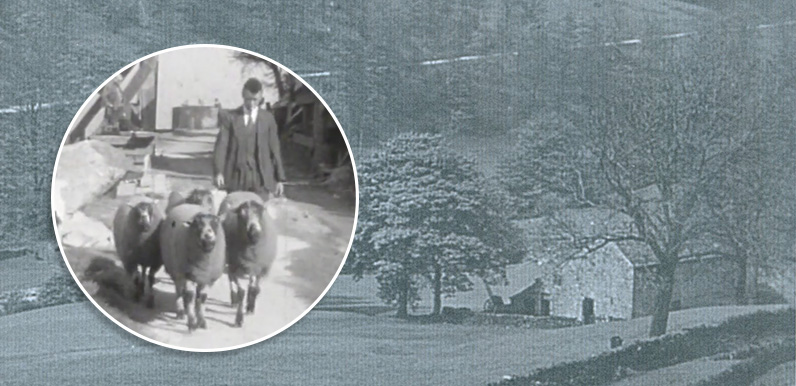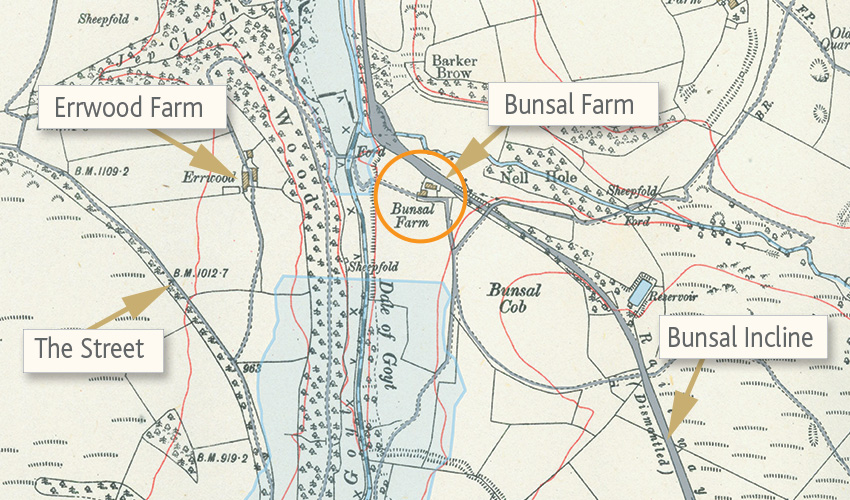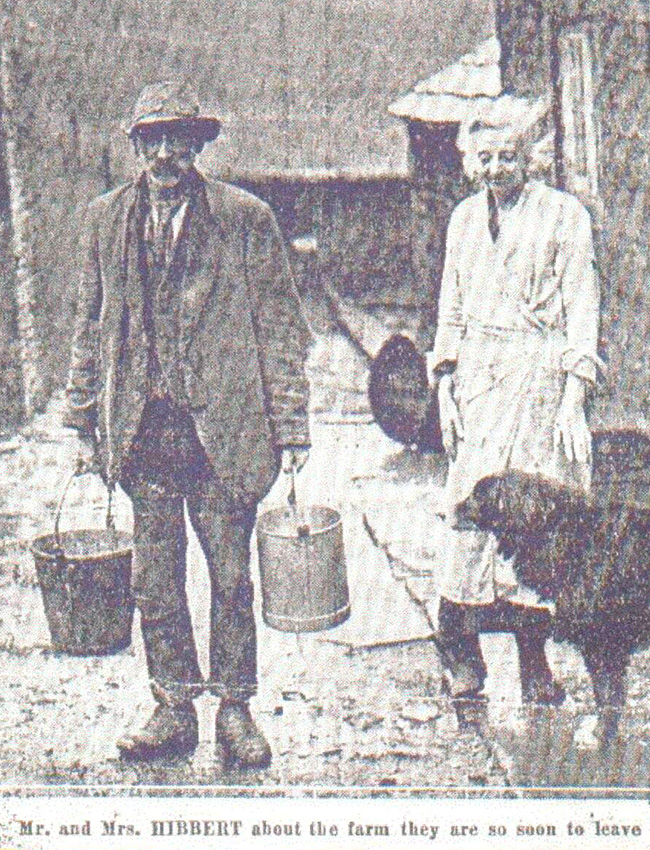The inset image of a well-dressed farmer herding his sheep through the construction site at Fernilee is taken from a 1932 cine-film of the inauguration ceremony. Click here to view the film in full.
My thanks to Margaret Hibbert for sending me this newspaper clipping from the 27th March 1936 edition of The Manchester Evening News about her distant relatives, Joe and Prudence Hibbert, who were the last farmers to leave the Goyt Valley during the construction of Fernilee Reservoir.
It provides a fascinating glimpse into the life of an elderly but self-sufficient couple who were forced from the land their family had farmed for generations. *NOTE: The writer has mistakenly referred to their farm as Gonsall throughout the article. It should have read Bunsal Farm.
For Two Hundred Years They Farmed the Goyt Land. And now a Fond Good-bye.
Hearts of Oak Are Their Rafters – Hey Ho for Parsley Hey!
To-day the Valley of the Goyt is a wilderness of stone farmhouses. Floods have covered the pasture, and one by one the farmers and their families have strapped their ancient bedsteads on to hay wagons, piled tin trunks into their milk trucks, and tracked off up the lane leading out from Derbyshire’s deceased village of Fernilee.
Only one family remains, and the grey smoke from their stone house on the hillsde. They are the Hibberts one-time lords of the Goyt Dale and owners of all the surrounding farms… now peasant agriculturists, with no more than a handful of pigs, sheep and cattle.
Rising… rising…
They still linger on in the doomed valley, finding it difficult to go. Their few sheep are now the only creatures left among the pastures, and are with foolish noses dabbling among the bog of the rising floods.
But old Joe Hibbert and his wife haven’t even started packing. Joe’s cows need milking, and under the grey stone walls of his fields are huddled the unsteady legged lambs of a new spring. He was born in Gonsall Farm 67 years ago in the small bedroom by the kitchen.
Joe has bumped his head on every projecting stick of furniture that the cottage contains, and he has watched his own children gaze up from among the blankets of this same kitchen… in bewilderment at the daylight of a new planet.
Three years ago…
Three years ago, there were 25 prospering farmsteads and more than 100 people in the Goyt Valley, which has been taken over by the Stockport Corporation for a great reservoir to suppliment its water supply.
Old Joe has grown sort of attached to the place.
His grey-haired wife says that to-morrow she will strip down the curtains from all the tiny upstairs windows, and take down the solitary picture from off its nail in the kitchen. But not to-day…
The two-hundred-year-old farm is certainly doomed, although its oak roof-beams are solid as the hour they were first hoisted laboriously into place.
“Heart of oak, are them thur rafters,” declares Joe, “and solid – why mesther, you would suttingly not believe. The missus tried to drive new nails into ’em for her kitchen drying line. But that oak bent them up like string. Best iron nails, they were, and crumpled up like string, they did! Yes, believe me!”
Huge sideboard
Oak is the delight of the Hibberts. When a remote ancestor of theirs first came to Gonsall Farm, in the days of Bonnie Prince Charlie, he built a huge oak sideboard and placed it along the far wall of the kitchen, flush with the skirting-boards.
Grey powder for the muskets and purple home-brewed wine was once stored in the cupboards of that side-board. To-day it holds the spare battery for the two-valve radio set.
But nobody has moved the sideboard itself and nobody ever would have done – except for the coming of the reservoir.
Even further back than the hibberts can remember, Gonsall Farm used to be a tavern on the main road between Buxton and London; that was in the days of flying coaches and highwaymen.
Guests bound for the mansion of my lord the Duke of Devonshire once pulled in their coach-teams at Gonsall Farm for meat and wine, or water for their sweating horses.
But on joe Hibbert’s dining table was a covering of chequered oil cloth, a two-pound pot of red jam, a tin of oat-cakes, and white farm crockery with pale gold rims.
The Hibberts are simple folk.
“I hope that durned dog hasn’t supped all my cow milk,” muttered Joe fondly as his sheep-dog Peter trotted urgently into the kitchen leaving a trail of wet toe-smudges on the scrubbed floor.
“Come here, lad!” He patted the dog’s suspiciously bulging flanks with his hands. “He’s plump enough,” was his ultimate verdict. “I’ll wager he’s had a good quaft.”
“Aye, well tell him to be settling down,” suggested his wife from the other side of the log-fire. “He’s paddled all the place up with his boggy feet.”
Peter the sheep-dog doesn’t know yet of the imminent removal. And until the actual day of departure he has no way of knowing. Nor had the rain-soaked black hen in the farmyard outside, pecking fretfully at barren cobbles.
But they will all have to be taken along soon. Forty head of cattle, 70 sheep, and 50 hens, must be packed into trucks and transplanted.
It will not be an easy task. And the fact that the new, man-made floods have swirled right across the bridle-path to the main road, cutting off the farm from all but a craggy track up the hillside, is not going to make it any easier.
That same water which is driving the Hibberts out of their home is at the same time hemming them in. They have only a few days more to puzzle out what they must do about it.
Fear for lambs
“For we can’t stay here for much longer, that I know,” says old Joe Hibbert. “Two of my ewes were in the water last Sunday, and I’m feared for the young lambs. Besides, the corporation have said we must go, and there’s no arguing with corporations. They aren’t human folk: Corporations are like Providence – you can’t set your hands or eyes on them.
But there is one bright star in the sky of this new, strange dawn that has come upon the Hibberts; they are to move once again into the demesne of the Duke of Devonshire … a little farm in Parsley Hey.
Margaret writes: Joe was the son of John Hibbert and Ellen Bennett of Calf Hey Farm and later of Bunsal, baptised 18th Apr 1869 at Taxal. His brother was Thomas Bennett Hibbert, baptised 12th Apr 1874. Joe’s wife was Prudence Beard. Joe was my 2nd cousin 3 times removed. The 1939 Register shows Joe Hibbert born 13 March 1869 and Prudence born 8 Aug 1874 at Cotes Field Hartington with Thomas B. Hibbert 16 May 1895 and James G Hibbert 11 May 1892. I would be interested in any other Hibbert relatives contacting me.
Page update
My thanks to Shirley for sending this photo of Joe and Prudence she found in her files of documents collected over some 20 years’ research into her family’s history (click to enlarge).
Pictured outside Bunsall Farm along with their sheepdog, Peter, the couple look like they’ve endured a fairly hard life. I wonder how they fared at their new farm in Parsley Hay.



Joe and Prudence were my great grandparents. As a family, they lived at Blackhill Gate Farm twice. My grandmother, Sarah Ellen Hibbert, married James Etchells and they lived at Blackhill. I believe Joe and Prudence got on very well at Parsley Hey.